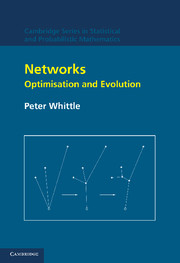Book contents
- Frontmatter
- Contents
- Acknowledgements
- Conventions on notation
- Tour d'Horizon
- Part I Distributional networks
- Part II Artificial neural networks
- Part III Processing networks
- Part IV Communication networks
- Appendix 1 Spatial integrals for the telephone problem
- Appendix 2 Bandit and tax processes
- Appendix 3 Random graphs and polymer models
- References
- Index
Part IV - Communication networks
Published online by Cambridge University Press: 23 November 2009
- Frontmatter
- Contents
- Acknowledgements
- Conventions on notation
- Tour d'Horizon
- Part I Distributional networks
- Part II Artificial neural networks
- Part III Processing networks
- Part IV Communication networks
- Appendix 1 Spatial integrals for the telephone problem
- Appendix 2 Bandit and tax processes
- Appendix 3 Random graphs and polymer models
- References
- Index
Summary
The topic of communication networks is now one of immense range and sophistication, concerned with the management of many competing forms of information traffic between many kinds of agents and devices. In this part we consider only some of the simplest representative cases that have implications for the design question. As ever, the problem is that design cannot be tackled before efficient operating policies have been agreed, and this first stage poses questions enough.
Loss networks are characterised by the fact that a call is accepted only if a clear path through the net is immediately available for it. As observed in Section 13.5, this makes them special in the class of queueing networks, in that they are by fiat both stable and queueless. Their operating rules then amount merely to the formulation of policies for call admission and routing. Under rather stark assumptions this reduces to solution of a simple linear programme. The analysis of Section 5.3 is invoked to show that the features of seminvariant costs, variable load and environmental penalty can all be incorporated. The hierarchical arrangement of exchanges suggested in Chapter 5 certainly gives the easiest analysis of reliability, and perhaps the best protection.
The stochastic upgrading in Chapter 16 of the basic version owes much to F. P. Kelly, although this is work he has now long left behind him. Kelly perceived the stochastic analogues of the shadow prices generated by the linear programme analysis, and their implications for routing and for updating of a network. A deeper contribution was his achievement of efficient self-regulation in the form of minimally interventionist and minimally centralised trunk reservation rules.
- Type
- Chapter
- Information
- NetworksOptimisation and Evolution, pp. 191 - 192Publisher: Cambridge University PressPrint publication year: 2007



